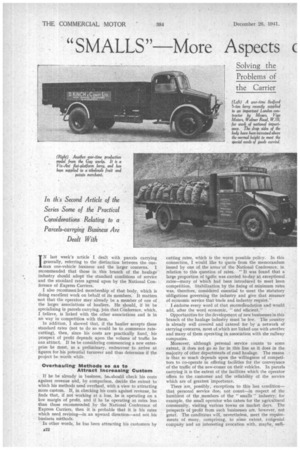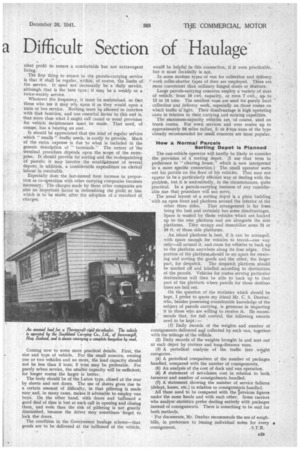"SMALLS" More Aspects c
Page 24

Page 25

If you've noticed an error in this article please click here to report it so we can fix it.
a Difficult Section of Haulage
Solving the Problems' of the Carrier
IN last week's article I dealt with parcels carrying generally, referring to the distinction between the oneman one-vehicle business and the larger concerns. I recommended that those in this branch of the haulage industry should adopt the standard conditions of service and the standard rates agreed upon by the National Conference of Express Carriers.
I also recommenied membership of that body, which is doing excellent work on behalf of its members. It matters amt that the operator may already be a member of one of the larget associations of hauliers. He should, if he be specializing in parcels carrying, join that Ctirtference, which, I believe, is linked with the other associations and is in no way in competition with them.
In addition, I showed that, if the haulier accepts these standard rates (not to do so would be to commence ratecutting), then, since his costs are practically fixed, his prospect of profit depends upon the volume of traffic he can attract. If he be considering commencing a new enterprise he must, as a preliminary, endeavour to arrive at figures for his potential turnover and thus determine if the project be worth while.
Overhauling Methods so as to Attract increasing Custom If he be already in business, hea should check his costs against revenue and, by comparison, decide the extent to which his methods need overhaul, with a view to attracting more custom. If, in checking his costs against revenue, he finds that, if not working at a loss, he is operating on a low margin of profit, and if he be operating at rates less than those recommended by the National Conference of Express Carriers, then it is probable that it is his rates which need revising—in an upward direction—and not his business methods.
In other words, he has been attracting his customers by
cutting rates, which is the worst possible policy. In this connection, I would like to quote from the memorandum issued by one of. the areas-of the National Conference, in relation to this question of rates. "It was found that a large proportion of tiaffic was carried to-day at exceptional rates—many of which had been introduced to meet keen competition. Stabilization by the fixing of minimum rates was, therefore, considered essential to meet the statutory obligations governing the industry and give that measure of economic service that trade and industry require."
I endorse every word of that recomnlendation and would add, after the word economic, "and efficient."
Opportunities for the development of new businesses in this branch of the haulage industry Must be few. The country is already well covered and catered for by a network of carrying concerns, most of which are linked one with another and many of them operating in association with the railway companies.
Moreover, although personal service counts to some extent, it does not go so far in this line as it does in the majority of other departments of road haulage. The reason is that so much depends upon the willingness of competitors to co-operate in offering facilities for the conveyance of the traffic of the new-comer on their vehicles. In parcels carrying it is the extent of the facilities which the operator offers to the customer and the reliability of the service which are of greatest importance.
There are, possibly, exceptions to this last condition— that personal service doe..: not count—in respect of the humblest of the _members of the " smalls" industry; for example, the small operator who caters for the agricultural community, visiting various towns on market days. The prospects of profit from such businesses ate, however, not great. The conditions will, nevertheless, meet the requirements of many, comprising, to vime extent, congenial company and an interesting avocation with, maybe, sail.
cient profit to ensure a comfortable but not extravagant living.
The first thing to ensure in the parcels-carrying service is that it shall be regular, within, of course, the limits of the service, it nped not necessarily be a daily service, although that is the best type; it may be a weekly or a twice-weekly service.
Whatever the frequency, it must be maintained, so that those who use it may rely upon it as they would upon a train or bus service. Nothing must be allowed to interfere with that function, and one essential factor to this end is, that more than what I might call casual or usual provision for vehicle maintenance must be made. That need, of couese, has a hearing on cost.
It should be appreciated that the kind of regular setvice which " smalls" traffic needs, is costly -to provide. Much of the extra expense is due to what is included in the generic description of " terminals." The extent of 'the terminal procedure depends upon the scope of the enterprise. It should provide for sorting and the re-despatching of parcels; it may involve the establishment of several. depots; in addition, a considerable expenditure on clerical labour is inevitable.
Especially does the last-named item increase in proportion as co-operation with other carrying companies becomes necessary. The charges made by these other companies are also an important factor in determining the profit or loss which is to be made, after the adoption of a standard of, charges.
Coming now to some more practical details. First, the size and type of vehicle. For the small concern, owning one or two vehicles and no more, the load capacity should not be less than 2 tons; 3 tons may be preferable. For purely urban service, the smaller capacity will be sufficient; for longer routes the larger is better.
The body should be of the Luton type, closed at the rear by sheets and not doors. The use of sheets gives rise to a certain amount of difficulty, in that pilfering is made easy and, in many cases, makes it advisable to employ van boys. On the other hand, with doors and tailboard a good deal of time is lost at each call in opening and closing them, and even then the risk of pilfering is not greatly diminished, because the driver may sometimes -forget to lock the doors.
The condition in the Government haulage scheme—that goods are to be delivered at the tailboard of the vehicle, would be helpful in this connection, if it were practicable, but it most decidedly is not.
In some modem types of van for collection and delivery work roller-shutter types of door are•employe.d. These are more convenient than ordinary hinged doors or shutters.
Large parcels-carrying concerns employ a variety of sizes of vehicle, from 10 cWt. capacity, or even 7 cwt„ up to 12 or 15 tons. The smallest vans are used for purely local collection and delivery work, especially on those routs on which traffic is' light. Their disadvantage is high operating costs in relation to their carrying and earning capatities.
The maximum-capacity vehicles are, of course, used on trunk routes. For town services and over routes up to approximately 50 miles radius, 2or 3-ton vans of the type already recommended for small concerns are most popular.
How a Normal Parcels Sorting Depot Is Planned The one-vehicle operator will hardly be likely to consider the provision of a sorting depot. (I use that term in preference to "clearing house," which is now interpreted in a more specific connection.) The small operator sorts out his parcels on the floor of his vehicles. That may not appear to be a particularly efficient way of dealing with the problem, but it is undoubtedly, in the circumstances, quite practical. In a parcels-carrying business of any considerable size that procedure will not serve.
The usual layout of a sorting depot is a plain building with an open front and platform around the interior of the other three sides. That arrangement is far from being the best and certainly has some disadvantages. Space is wasted by those vehicles which are backed up to the rear platform and are alongside the side platforms. They occupy and immobilize some 26 or 30 ft of those side platforms.
An island platform is best, if it can be arranged, with space enough for vehicles to travel—one way only—all around it, and room for vehicles to back up to the platform anywhere along its four edges. One portion of the platform.should be set apart for receiv-ing and sorting the goods and the other, the larger part, for despatch. The despatch platform should be marked off and labelled according to destination of the parcels. Vehicles for routes serving particular destinations will then be able to back up to that part of the platform where parcels for those destinations are laid out.
On the question of the statistics which should be kept, I prefer to quote my friend Mr. C: S. Dunbar, who, besides possessing considerable knowledge of the subject of parcels carrying, is generous in imparting it to those who are willing to receive it. He recommends that, for full control, the following records need to be kept :— (1) Daily records of the weights and number of consignments delivered and collected by each van, together. with the mileage of the vehicle.
(2) Daily records of the 'weights brought in and sent out at each depot by carriers and long-distance vans.
(3) A periodical analysis of the traffic into . weight categories.
(4) A periodical comparison of the number of packages handled, compared with the number of consignments.
(5) An analysis of the cost of dock and van operation.
(6) A statement of net-claims cost in relation to both turnover and number of consigthents handled.
(7) A statement showing the number of service failures (delays, losses, etc.) in relation to consignments handled.
All these need to be compared with the is revious figures under the same heads and with each other. Some carriers who analyse statistics prefer dealing entirely with packages instead of consignments. There is something to be said for both methods.
• For documents, Mr. Dunbar recommends the use of weighbills, in preference to issuing individual notes for every • consignment. S.T.R.




















































